The Chocolate Goldendoodle might not be easy to breed or acquire, but it is definitely worth all the effort, especially if you’re looking for a wonderful and unique pup.
Goldendoodles are generally known as great family pets that will devote all their love and attention to their owner.
Parti, black, or red Goldendoodles – we love this beautiful mixed breed in every shade they come in, but the majority will agree that there is something special about these chocolate pooches.
However, keep in mind that although they’re as sweet as chocolate, you’re not supposed to eat them.
Now, it’s time to enter the world of these furry choco beauties and discover why they are so special to many dog lovers.
What Is The Chocolate Goldendoodle?

Essentially, the definition of a chocolate Goldendoodle is a combination of Poodle pooches and Golden Retrievers that is colored in the chocolate (brown) shade.
There are a few ways to achieve this type of shade in your pup. In most cases, Goldendoodles inherit the color gene from the Poodle parent, which generally comes in a greater number of shades than the Golden Retriever.
However, it is not enough just to have a Poodle in a chocolate hue; the breeder has to be sure that the color gene of this parent breed is the dominant one in the mix. That is why the generation of the Doodle pup plays an important role in achieving a certain color.
For example, a Goldendoodle of the F1B generation will have greater chances of inheriting the chocolate shade than an F1 Goldie pup simply because the majority of genes come from the Poodle (three-quarters, to be exact).
If both of the parent breeds are already in chocolate hue, there’s a great chance their offspring will inherit either a dark chocolate coat or a lighter hue of the same shade.
Goldendoodles with a chocolate coat are quite popular among Doodle enthusiasts, which is why a great number of Goldendoodle breeders try their best to achieve this particular shade.
Still, finding a chocolate Goldendoodle is rather a challenging task as they’re not as common as Goldendoodles in other shades.
Where Does The Chocolate Come From?
If you want a chocolate-colored Goldendoodle, you need to make sure that either one of the parent breeds being crossed has a chocolate coat or both of the parent breeds have one.
Many people get confused when they notice that the expected litter of Goldendoodle puppies comes in silver-shaded fur. However, this should not be considered as a fault or a mistake by any means as chocolate Goldendoodles often get born in this type of shade.
This color can be dominant on their fur for quite a long time, but the chocolate hue should take over after they turn two.
As I mentioned in the previous paragraphs, in order to get a chocolate Doodle, you will need to breed two chocolate canines or a Poodle with a dominant chocolate shade. The best way to achieve this is to breed an F1B chocolate Goldendoodle.
Keep in mind that an F1B pup contains 75% of Poodle genes, while the first generation (F1) contains 25% less. Therefore, it’s natural to state that an F1B Goldendoodle has way more chances to be of chocolate hue.
If the combination of purebred parent breeds includes only one chocolate pup, the chances for a chocolate Dood are quite low.
Is Chocolate An Uncommon Shade?
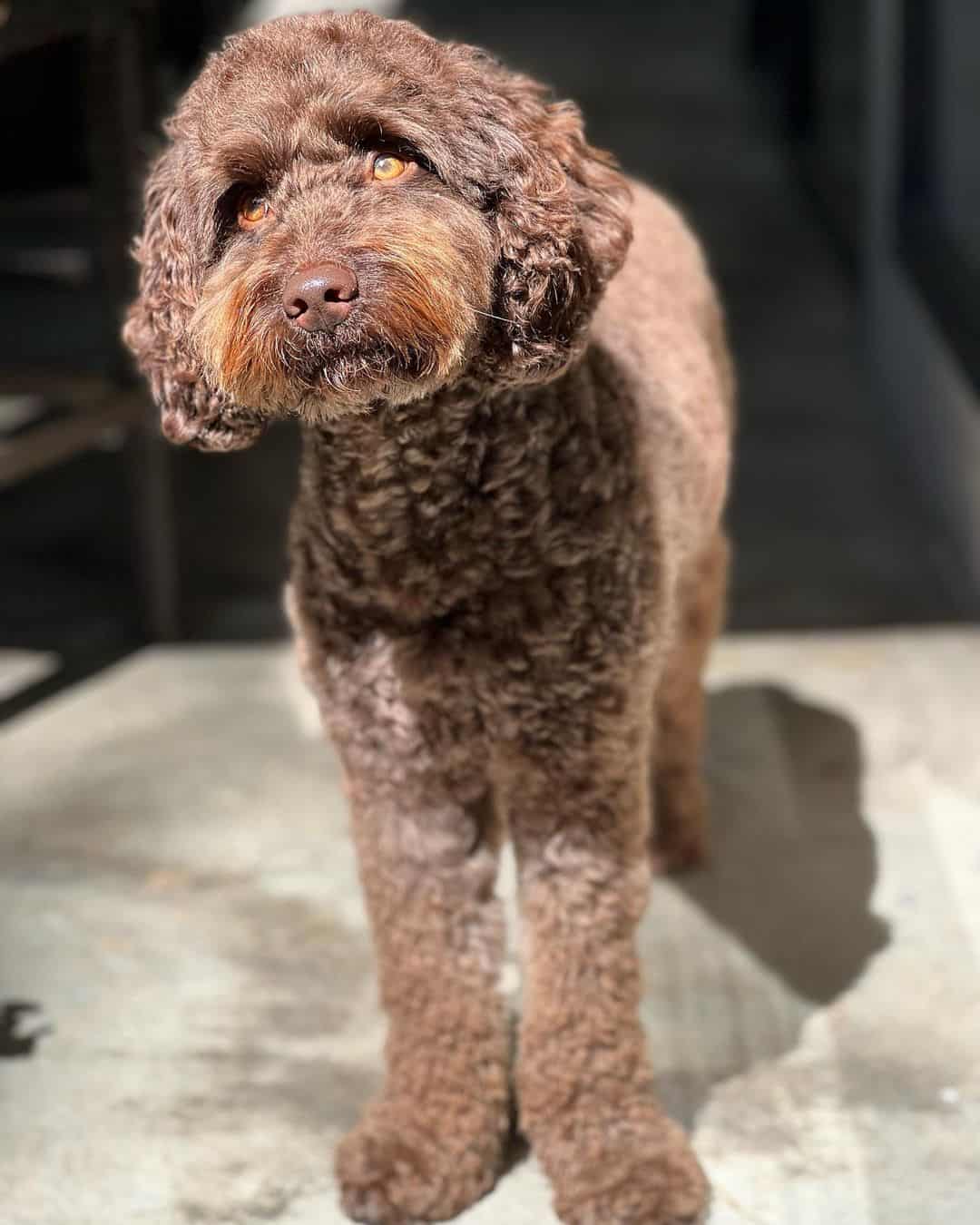
We already defined the chocolate shade as a rather uncommon hue among Goldendoodles, which might be a surprise for some as both parent breeds have this shade in the range of their coat colors.
The main reason why the chocolate coat is so rare is the fact that this shade comes from a recessive gene that is rarely passed on to future generations.
This color can be inherited only if both canines possess the recessive gene in their DNA. This is why multigenerational dogs and two purebred canines of the same shade usually produce pups of chocolate hue.
This all sounds good in theory, but it’s fairly difficult to find a chocolate Poodle and a Golden Retriever, so the chances of them being mixed and producing a choco Doodle is a challenging task.
A skilled breeder, on the other hand, can focus solely on the breeding of chocolate-colored Poodles in order to ensure that the chocolate gene is the more prominent one in the Goldendoodle.
Those who reside in an area without Poodles or Golden Retrievers that are in this particular shade can try to connect with breeders from other areas until they find what they need.
Make sure that the breeder you contact is trustworthy and reputable as there are many puppy mills and scammers that offer exactly what you need, but they either never deliver or you end up with a sick puppy of a mixed breed you didn’t even ask for.
Finding chocolate-colored dogs isn’t an easy task, but it’s not impossible either.
Types Of Chocolate Goldendoodle Coats
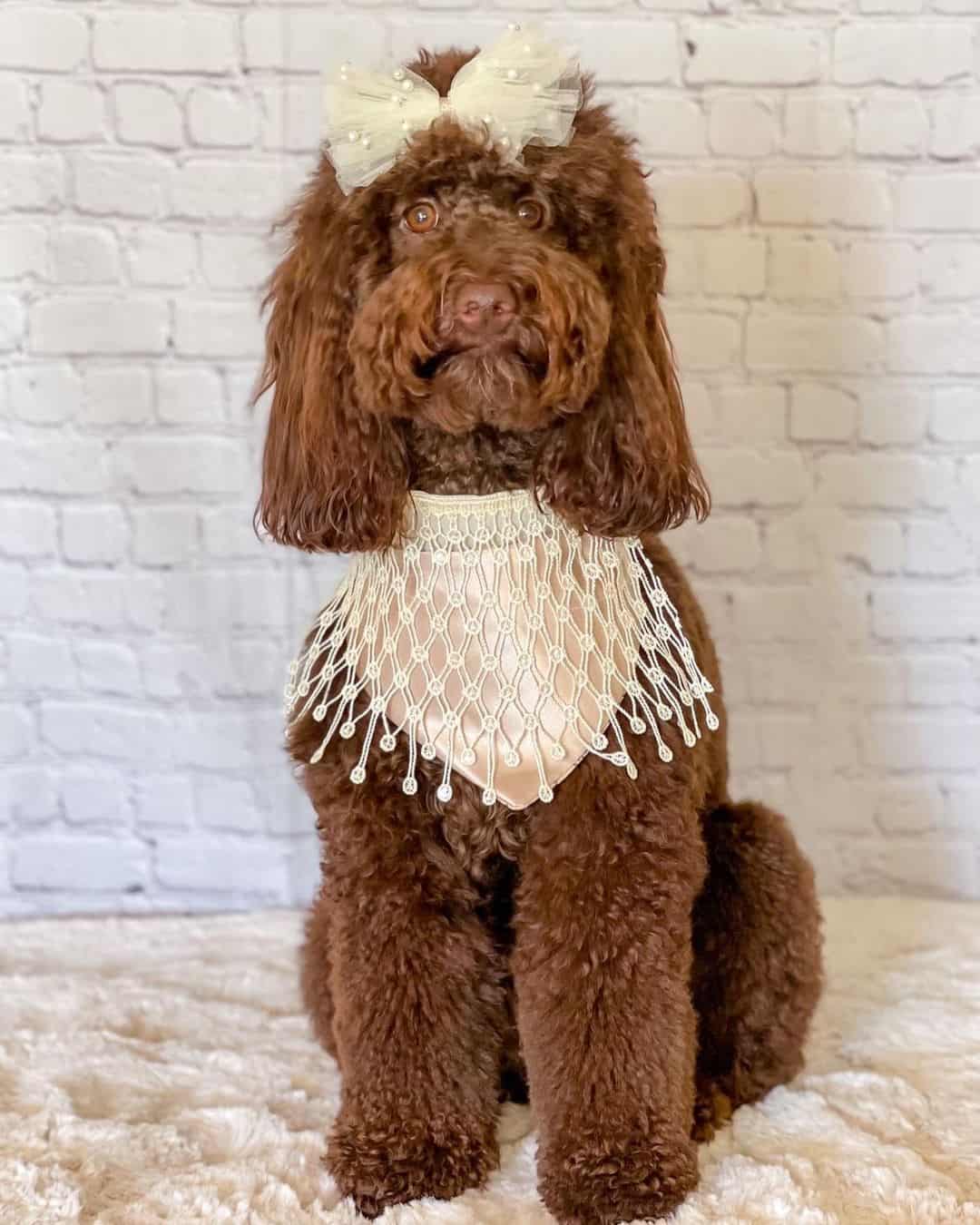
Even when you find a Goldendoodle with a chocolate coat, you will still need to determine the type of its fur. Although this doesn’t sound overly complicated, it’s not easy to do either.
This category usually determines the coat textures these pups can possess, but I’d like to mention the changes that their coat might go through in terms of colors as well.
For example, chocolate Goldendoodles can have different types of this hue throughout their life. The majority of choco Goldendoodles are born in a silvery-gray hue, which changes as they get older.
However, this isn’t the only change in the shade that these pups go through. It is a common occurrence that canines change their fur hue as they grow old, so they might easily end up with a lighter shade of brown as seniors.
The final coat shade can be determined during early puppyhood by examining the area around the pup’s eyes and nose.
Pay particular attention to the color of the coat around the snout of the Goldendoodle as this will provide you with some insight into the color that the Goldendoodle will have when it grows.
The texture doesn’t change as much, so there’s no need for you to worry about what kind of coat your Goldendoodle pup will have when it becomes older.
Still, if you’d like to know more about the possible types of fur that Goldendoodles can come with in general, here’s a little guide:
Curly Coats
Goldendoodles with this type of fur have become increasingly popular in the past few years. However, a common misconception is that the request for curly Goldendoodles is based on their cuteness.
Actually, one of the main reasons why the curly coat type of the Goldendoodle is popular is the fact that they’re simpler to maintain and care for than the other two types of coats.
Fur with this style provides the Goldendoodle a look that is more similar to that of a Poodle, and as a result, it sheds far less than pups with straight hair.
This means that your Goldendoodle is likely hypoallergenic, which is fantastic news for those who adore dogs, yet suffer from allergies to canine hair.
However, keep in mind that these pups still require thorough grooming, especially when it comes to brushing. Curly Goldendoodles need to be brushed at least once a day as they might develop knots and tangles throughout their fur.
RELATED: Best Brush For A Goldendoodle: Top 12 Tools For Doodle Coat
Straight Coats
Straight-coated chocolate Doodles are not as common as other types of Goldendoodles, but that doesn’t make them quite high in demand either.
The main reason why these pups are rare is that they can be bred only if the mixed-bred offspring inherits the coat gene from a chocolate Golden Retriever.
This type of coat is perfect for brushing in terms of mats and knots as they don’t occur nearly as much as in a wavy or a curly coat.
However, when it comes to grooming in general, Goldendoodle pups with straight hair aren’t so easy to keep up as they shed quite a lot, just like their parent breed, the Golden Retriever.
Therefore, you might expect to find more hair on your carpets and sofa if you own the straight coat type of these chocolate cuties, but you can prevent that simply by regularly brushing your pooch.
Wavy Coats
This is probably one of the most frequent types of fur that Goldendoodles can come in, at least according to the number of pups that can be seen on the streets and in dog parks.
The wavy coat type of these pups might not possess that iconic teddy-bear look, but they’re still adorable. Their hair isn’t as curly as the first type we mentioned, but they do have beautiful waves throughout their fur.
These doggies are considered the easiest to keep up when it comes to grooming as they don’t shed as much as pooches with a straight coat, although they might leave a few more hairs around your house than curly puppies.
Their shaggy coat won’t become matted or tangled often either, especially if you brush them with suitable tools on a regular basis.
They might not be exactly hypoallergenic, but chocolate Goldendoodles with wavy hair might be suitable even for people with mild sensitivities to allergens (although I’d still recommend a consultation with a health professional before getting this type of pup).
It is recommended that you devote at least one or two hours every week to the task of grooming your favorite furry companion.
Grooming isn’t just about keeping your pup clean. This process also makes them happy, healthy, and comfortable. Therefore, even if you can’t find enough time for it, you can at least take your pup to a professional groomer who will do this task for you.
Do Choco Goldendoodles Change Shades?
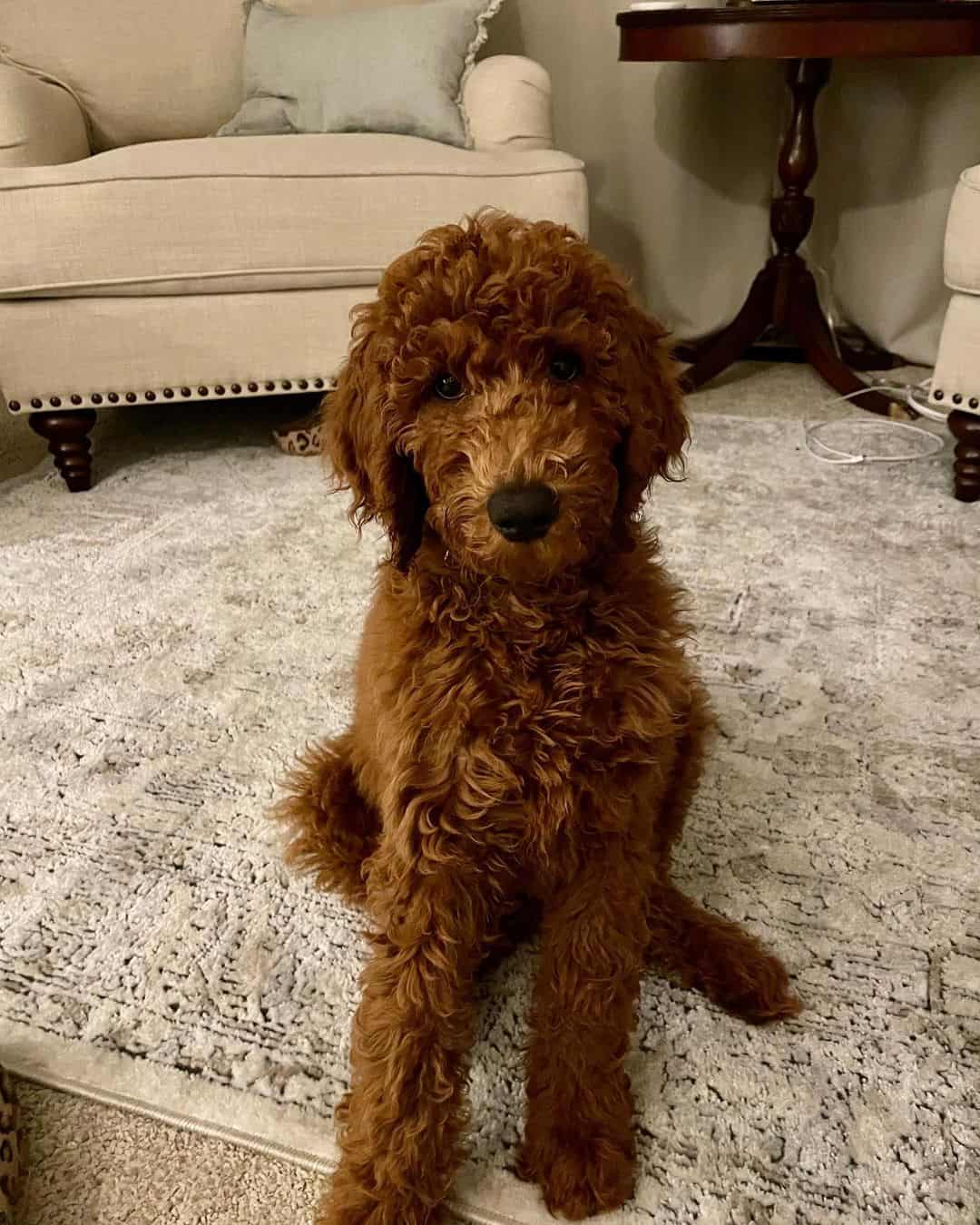
As we mentioned previously in this article, it’s common knowledge that pups, including chocolate Goldendoodles, might experience changes in their coat shades as they grow older.
However, there might be some exceptions in Goldendoodles with the chocolate coat color.
Some Doodles might have slight changes in their fur shade, such as gaining a silver-beige (cafe au lait) kind of gloss over their chocolate fur, while the coat of others might switch to a light brown hue from a dark chocolate shade as they mature.
This is an indication of maturity, and it should not be taken too seriously at this point in time.
If getting a chocolate Goldendoodle is an absolute necessity for you, consult with a reputable breeder about the frequency of puppies changing coat colors that they might have noticed or heard about.
The majority of Goldendoodle breeders should be able to provide you with detailed information about the coat of the puppies they breed.
Can Chocolate Color Affect A Goldendoodle’s Temperament?
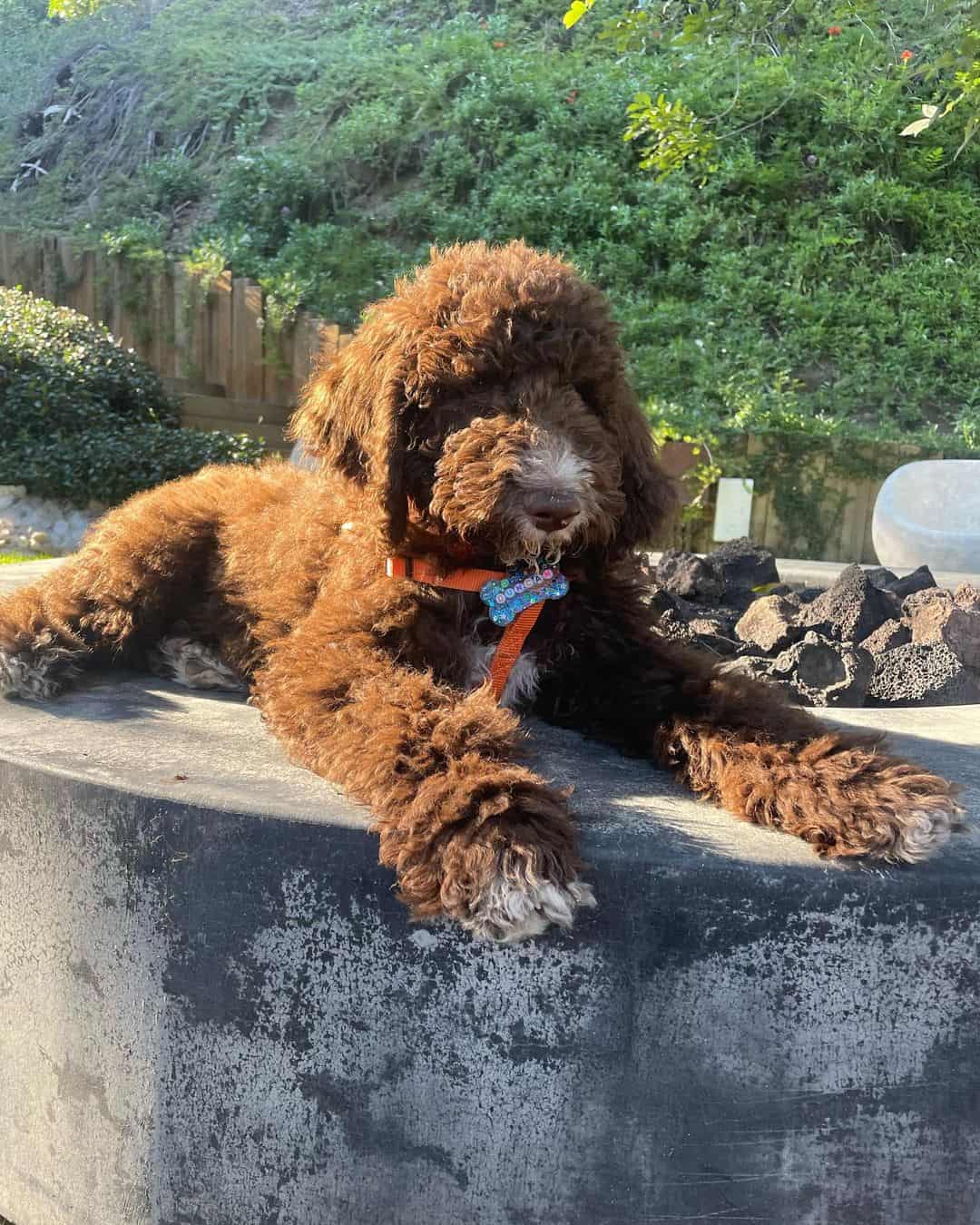
Generally speaking, it’s practically impossible for the color gene to have any effect on the temperament of a certain canine. The same goes for Goldendoodles, Labradoodles, Sheepadoodles, and any other purebred or mixed-breed pup.
Goldendoodle dogs are very intelligent and easy to train as they’re obedient, loyal, and willing to follow their leader (owner). However, they also love to cuddle a lot, like true lap pooches, and they make friends easily, even with strangers.
All these traits don’t have much to do with Goldendoodle colors, but with other genes that they inherit from their purebred parents.
Considering that Poodles and Golden Retrievers share quite a few personality traits, it’s easy to guess what kind of temperament their offspring will have.
Still, there might be certain differences that will show which parent the Goldendoodle inherited the traits from.
If they resemble Goldens more, these pups might develop separation anxiety much easier than puppies with Poodle genes.
In general, they are kind and affectionate family pets that take pleasure in spending time with their family, engaging in various activities such as playing games and running around with children.
So, What Does Color Have To Do With It?
As we said, coat shades can’t have any direct impact on the behavior of your doggo since shade genes don’t have any influence over the genes and processes in the dog’s gene pool.
However, colors might influence the way other people see your pet. Certain coat shades might make your pup either look friendlier or more intimidating.
READ NEXT: 20 Scariest Dog Breeds: The Best Dogs To Keep Out Intruders
For example, black canines, including black Goldendoodles, can look more powerful than white pups, which usually give off friendly vibes as they look adorable.
If you get a combination of an apricot or a chocolate Goldendoodle with a curly coat, your pup will get lots of “looks just like a Teddy bear” comments.
So, essentially, the fact that you own a chocolate Goldendoodle will have nothing to do with its personality, but it will have quite a lot to do with how others perceive it.
What Is The Size Of Chocolate Goldendoodles?
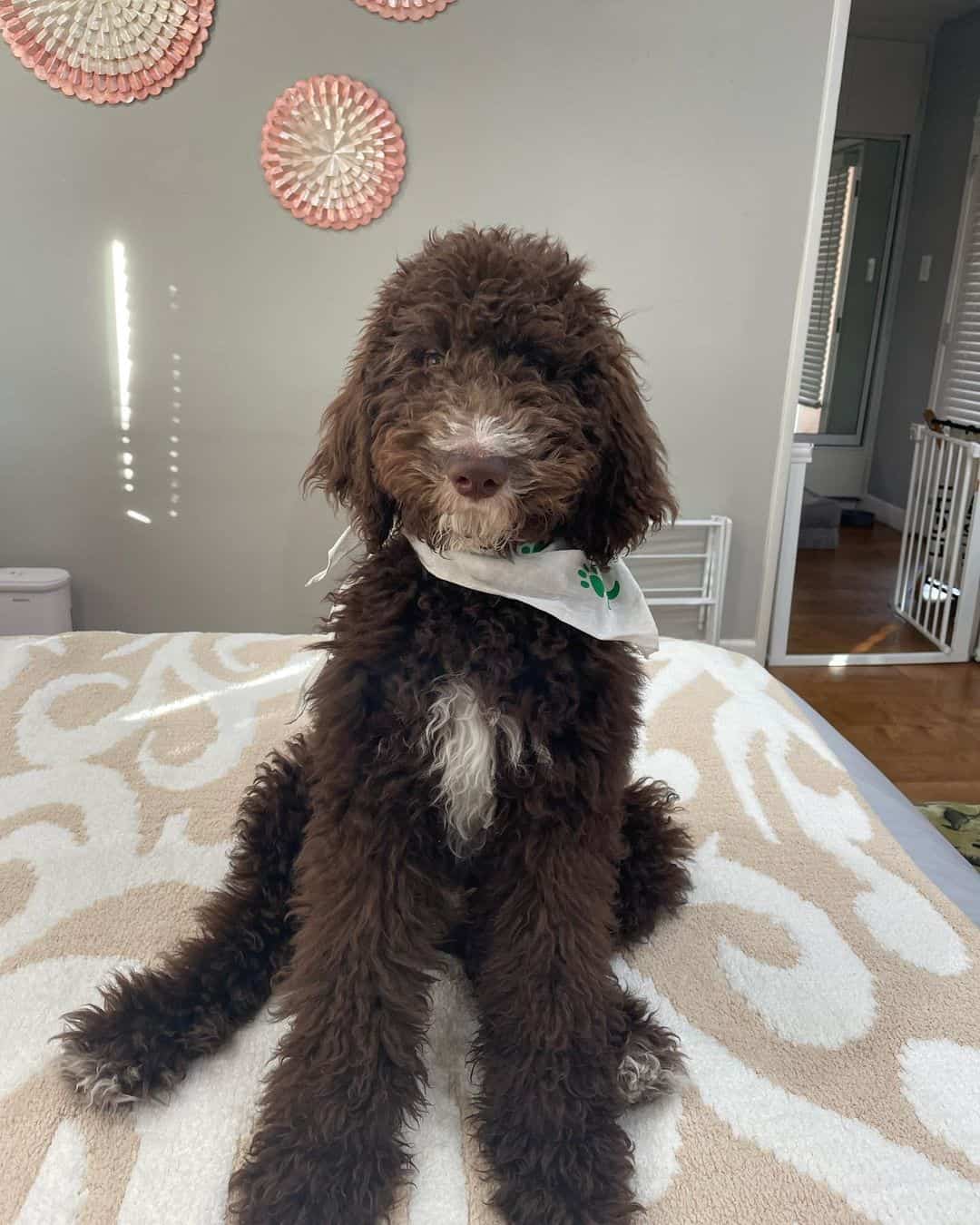
Generally, Golden Retrievers are medium-to-large-sized doggies that almost always appear in one size. There is a miniature Golden Retriever as well, but this type of pup is rather a combination of these canines with other breeds (Cocker Spaniels and, in some cases, Poodles).
On the other hand, Poodles come in three different sizes: the toy, the mini, and the standard Poodle.
RELATED: 10 Amazing Miniature Poodle Breeders In The USA
In most cases, the size of your Goldendoodle companion will be strongly impacted by the contributions made by the Poodle parent of your Goldendoodle.
That is why it can be said that chocolate Goldendoodles come in three different sizes, just like their Poodle parents.
Mini Goldendoodles
Miniature choco pups have the ability to be further subdivided into two groups known as tiny and teacup Goldendoodles.
Their weight can be anywhere from 15 to 30 pounds, with a height of up to 17 inches, although most pooches stay below this line.
Mini Goldie crossbreeds are usually considered among the best family pets for people who live in apartments because of their size and temperament.
Medium Goldendoodles
Families that are looking for a pet of fairly moderate size and a lovely personality will love medium chocolate Goldendoodles.
These pups are the most common type of Goldendoodles regarding size, and they can be found in almost every coat shade.
These pups are definitely bigger than small-sized Doodles as they can grow up to 20 inches at most, and weigh up to 60 lbs, which is quite a lot, especially if you have a pet that still thinks it’s a puppy rather than an adult dog.
Standard Goldendoodles
The Standard Chocolate Goldendoodle is a lovable Goldendoodle type that shows its best when maintained in a warm home that provides ample room for this pup to run around and play.
Due to their strong intellectual skills, and the fact that they are easily trainable, these pups are also a good choice for pets that are kept inside the house or in an apartment.
When it comes to their physical appearance, standard choco puppies might look much bigger than the other two types of Goldies mainly because the standard chocolate Goldendoodle size is about 24 inches in height, and up to 80 lbs in weight.
Essentially, if you decide to adopt a Goldendoodle pup, make sure to check which type of Poodle it comes from. This is the best way to find out the size of your future pet once it becomes mature.
Generations Of Chocolate Goldendoodles
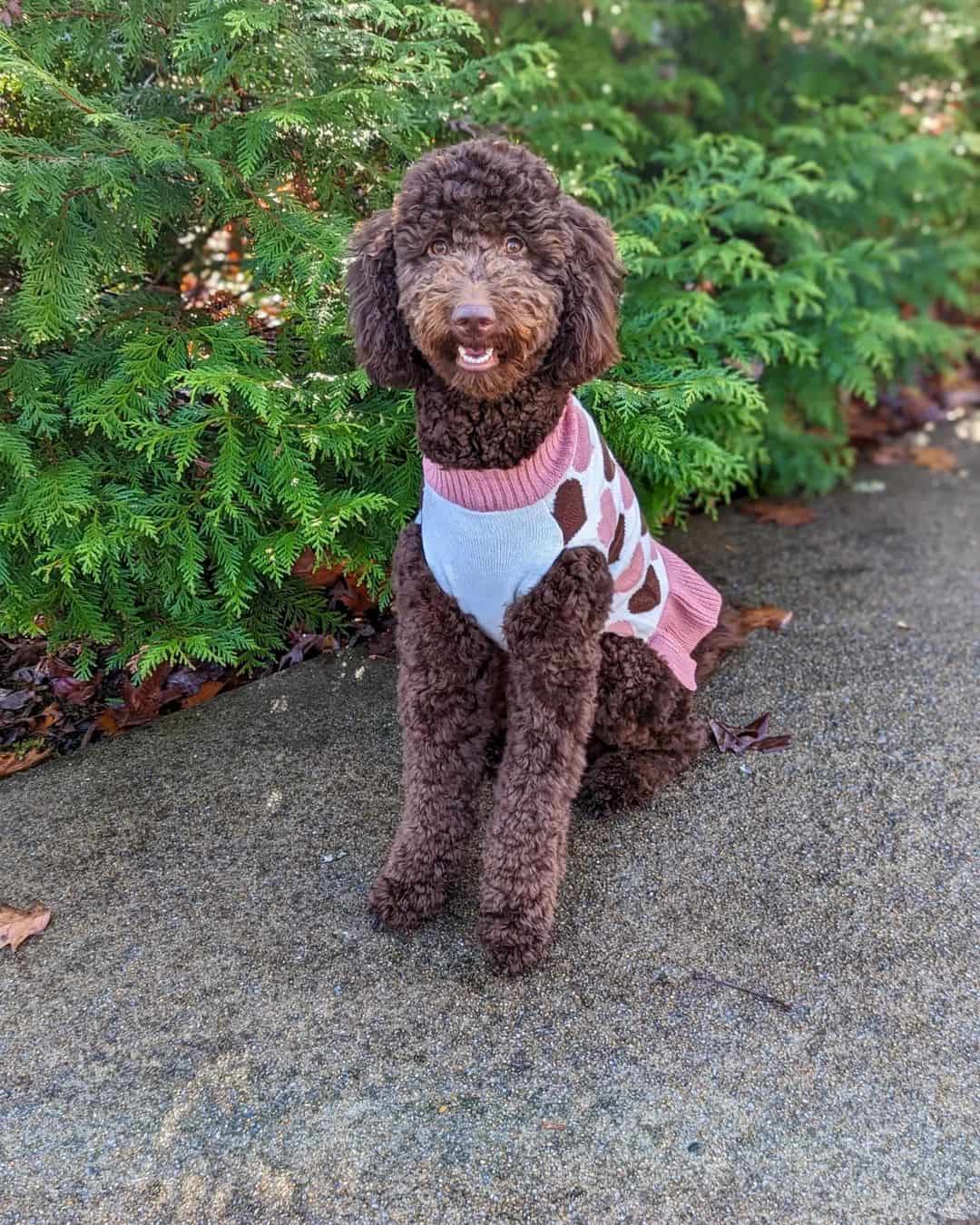
As you may already know, Goldendoodles, just like other Doodles, can be bred by two purebred parents or by the already-combined pups that are old enough for breeding.
We will examine a few generations out of the entire number of Goldendoodle generations and discuss the breeding methods, which might be a helpful guide for achieving the right shade of a chocolate-coated Goldendoodle from these generations.
F1 Chocolate Goldendoodle
This is the basic combination of two purebred doggies – Poodles and Golden Retrievers, which is why they’re also known as F1 Goldendoodles.
The resulting Goldendoodle will have the Golden Retriever gene in half and the Poodle gene in the other half of the gene pool.
In order to produce a chocolate-coated F1 Goldendoodle, you will need a chocolate-coated Poodle (this is a must) in addition to a Golden Retriever of any hue (Chocolate Golden Retrievers would be perfect).
You should have a flawless Chocolate Goldendoodle if the gene from the Poodle is more dominant than the one from the Goldendoodle.
F1B Generation
An F1 generation Goldendoodle is a good generation. Still, the F1B Goldendoodle is an even better generation since it provides you with a higher chance of receiving a Goldendoodle variant that you like.
This happens because the F1B lineage is composed of Golden Retrievers and Poodles in the ratio of 75% to 25%, respectively.
As a result, the Poodle gene will have a higher chance of becoming dominant than the Golden Retriever gene.
However, if you want a Goldendoodle with a chocolate coat, you will still need to breed a chocolate Goldendoodle with a Golden Retriever, preferably a chocolate Golden Retriever.
F3 Generation
The F3 Goldendoodle, also known as the multigene Goldendoodle, is the one that offers the greatest chance of producing the Goldendoodle variant that is sought after.
This is due to the fact that in order to obtain a Goldendoodle of the F3 generation, you would need two Goldendoodles of the F1B generation, each of which would have 75% Poodle genes and 25% Golden Retriever genes.
It may not be simple to get two chocolate F1B Goldendoodles. Still, if you manage to breed two F1Bs, there is a greater possibility that you will end up with a regular chocolate Goldendoodle that has a hypoallergenic coat.
Are There Any Variations Of This Shade?
Actually, there isn’t a great variety of coat colors when it comes to chocolate doggies. To be exact, there are only two shades of this color – dark chocolate, and coffee brown.
In contrast to the darker color variation seen in Goldendoodles, coffee brown has a brown hue that is not quite as deep.
These pups usually have a beautiful and shiny coat that is rather light in shade, which is why not all choco Goldens look the same.
Are Chocolate Goldendoodles Prone To Any Health Issues?
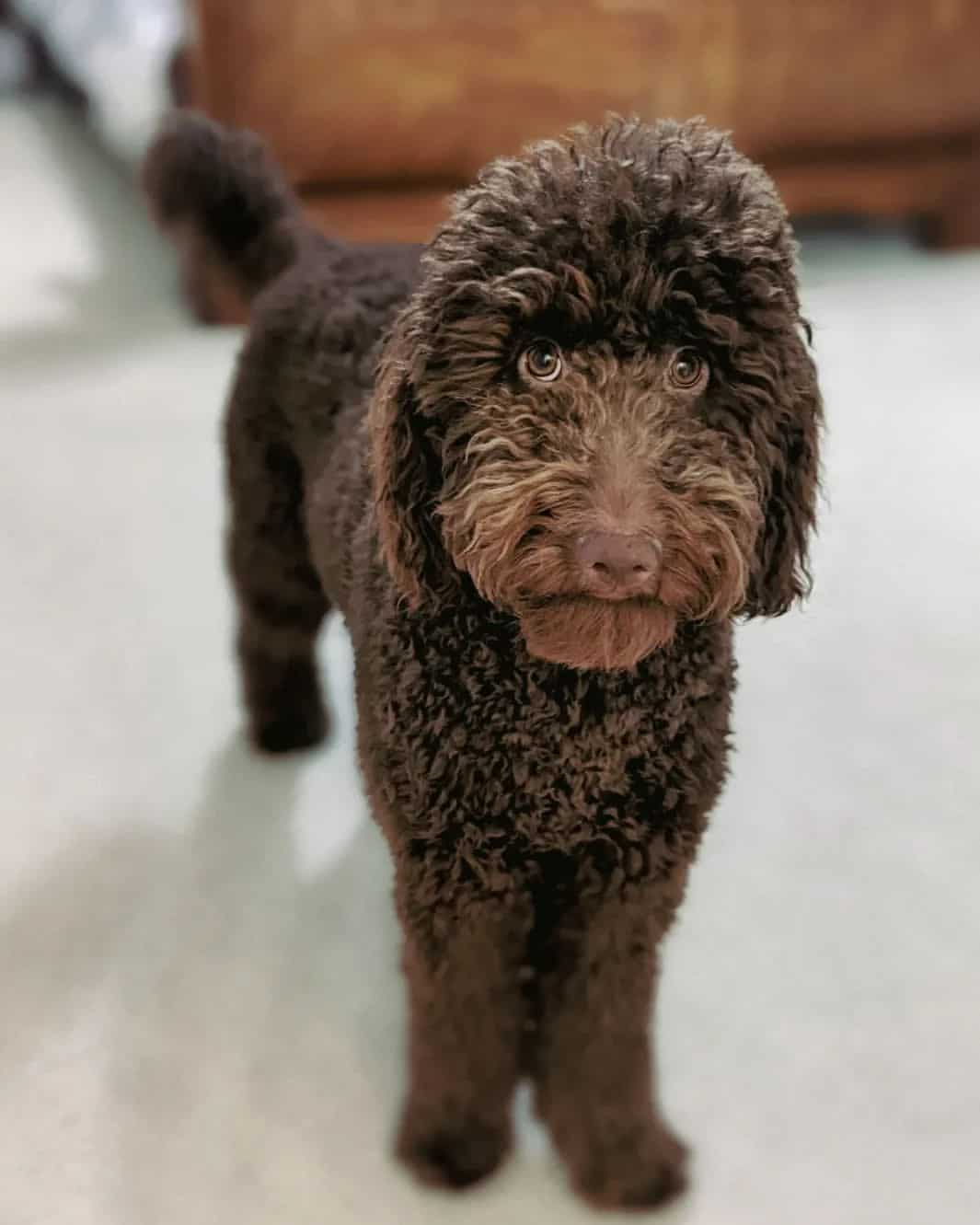
Even though the Goldendoodle has a higher resistance to diseases and health problems than either of its parents, the Golden Retriever or the Poodle, it is still prone to certain medical conditions, especially during its senior years.
Before you get a chocolate Goldendoodle puppy, or any pooch of this breed, from a breeder, it is very significant that you ask or make inquiries from the Goldendoodle breeder about the breeding practice used on the Goldendoodle.
This is because even though the Goldendoodle has a higher tolerance to diseases and health defects, there are still certain conditions that they will rarely avoid.
Cataracts
Cataracts, which are also referred to as cloudy eyes, might do significant harm to the Goldendoodle.
In this scenario, the Goldendoodle’s eyesight will become clouded with a white substance, and cataracts could eventually worsen to the point where the Goldendoodle could become entirely blind.
Due to the fact that the condition cannot be treated, it has the potential to become severe in older Goldendoodles.
However, Goldendoodles that are younger and have not yet undergone surgery have a chance to recover their vision.
Epilepsy
The Goldendoodle tends to suffer from this condition rather frequently. They inherit this illness from both of their breeding parents – the Golden Retriever and the Poodle, making it not only extremely dangerous, but also life-threatening.
Because this problem might be avoided with the right kind of breeding procedure, it is imperative that you always do business with a breeder who has a good reputation.
Skin Issues
It’s possible that your Goldendoodle will acquire skin issues over time. These problems can be brought on by inappropriate grooming techniques as well as unhealthy lifestyles (low-quality dog food, bad hygiene, etc.), or simply skin sensitivity that Goldendoodles have.
The Goldendoodle may experience discomfort and even agony as a result of dermatitis reactions, patches, and other abnormalities that can be caused by these factors.
Goldendoodles have delicate skin, so it is imperative that you give them the proper care they need on a regular basis if you want them to remain happy and energetic.
Hip Dysplasia
Large dog breeds, such as the Poodle and the Golden Retriever, have a higher risk of developing hip and elbow dysplasia than smaller dog breeds.
This takes place whenever there is a displacement that is not consistent with the normal functioning of the ball and socket joint.
The Goldendoodle may be able to only move partially or not at all as a result of the severe discomfort caused by the ailment. Surgery may be necessary for Goldendoodles diagnosed with hip dysplasia if the problem worsens to an unacceptable level.
Choco Goldendoodle Life Expectancy
The average lifespan of your pup depends on several quite important factors such as breeding practices, overall health, and the environment in which the pup is raised.
According to dog experts and general guidelines, a chocolate Goldendoodle is expected to live anywhere from ten to fifteen years.
One thing is for sure – in most cases, these pups live longer than their Golden Retriever parents, which essentially means that they usually live for at least 12 years.
The span of the Goldendoodle’s life expectancy cannot be affected by the coat shade that the pup is covered with, so it doesn’t really matter which hue their fur really is.
Wrapping Up
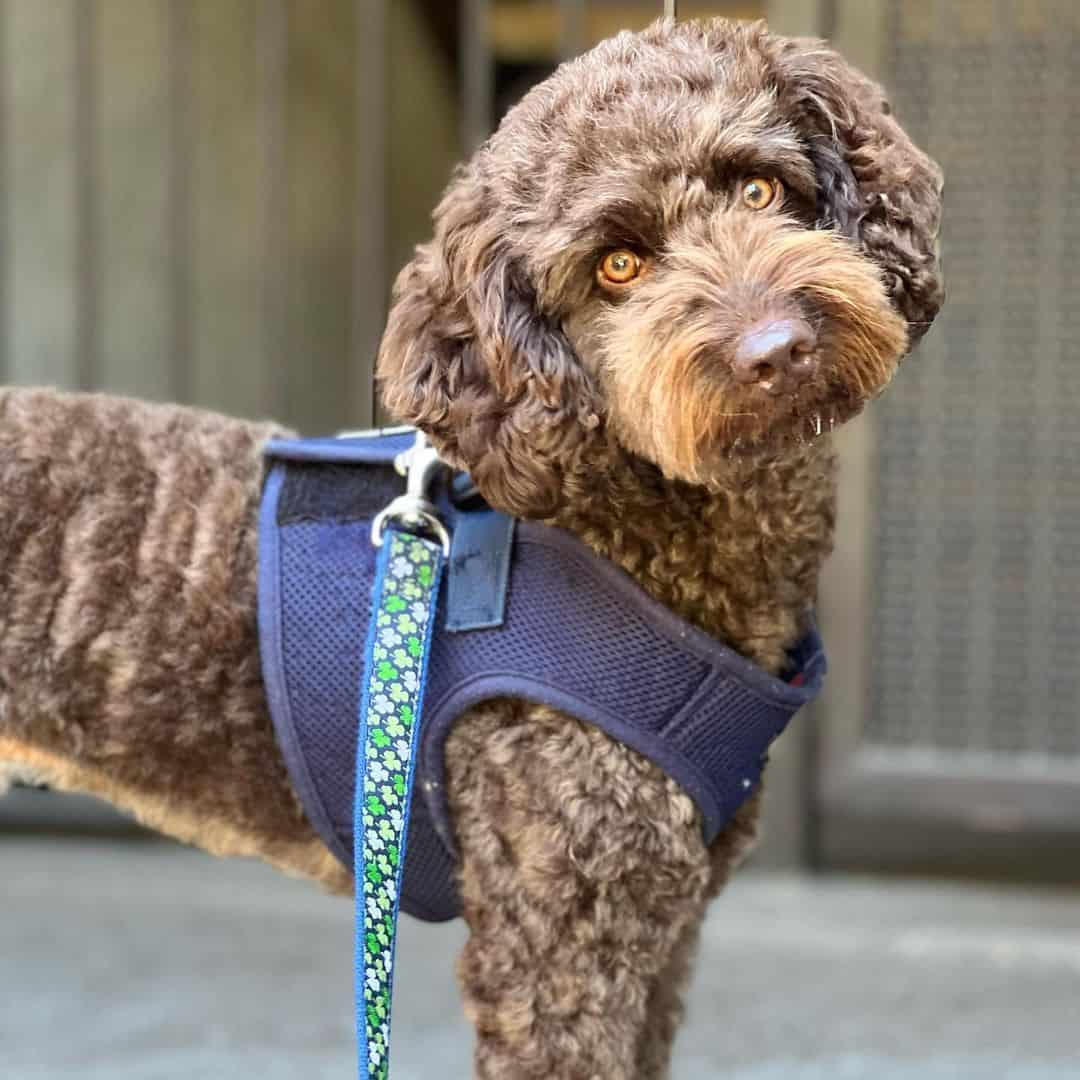
Chocolate Goldendoodles are just as adorable as sable, cream, merle, blue, white, black and white, and red Goldendoodles.
This rare color enhances the Poodle-like appearance that these puppies mostly inherit, turning them into wonderful Teddy bear-like pups.
Poodles come in different colors, and it’s difficult to predict which shade your pup will come in.
However, if you follow the breeding process of chocolate Goldendoodles, there’s a high chance you’ll get one.
READ NEXT:
Shaved Goldendoodle: A Trend To Skip Or Not?
Goldendoodle Feeding Chart: The Golden Feeding Guide
The Ultimate Guide To The Flat Coat Goldendoodle















